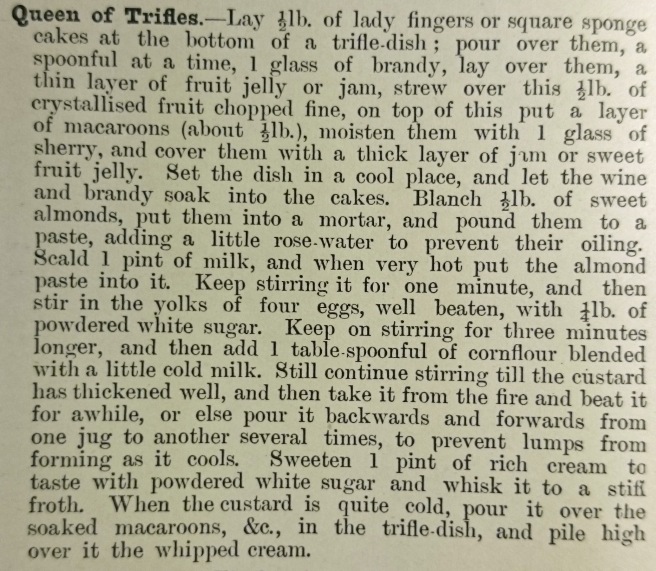Today’s The Kitchen Cabinet comes from Audley End in Essex. It’s a house I know well, having pretty much lived there during the second year of my PhD. I led a crack team of costumed interpreters working in the service wing for 5 years, during which time we gutted, plucked, pounded, strained, chopped, cut and boiled more food than I thought possible. The team is still going strong, and Audley remains, along with Hampton Court, one of the very few places you can see professional live cookery and interact with the cooks. It’s all set in 1881, and the team is fully in character, providing a way into the history of that period which is both engaging and accessible, while being underpinned by very rigorous research. I won’t go on about it, but I am quite proud of the whole thing.
Inevitably, as we were recording at Audley, the show had a rather Victorian feel. My contribution was a trifle. I loathe trifle. It’s a texture thing (soggy cake, the ear wax of beelzebub), and a taste thing (sherry, the spit of beelzebub). I have hideous childhood memories of trifles with tinned fruit.(The pears! The grit! The syrup! The ik!), custard powder and squirty cream. It’s like a Proustian nightmare. But trifle was asked for, and trifle I did.
If anyone out there reaaaally likes trifle, there is an excellent book on the subject*, filled with more recipes than you could ever desire. It also covers the history of the dish, and the variants on the theme, such as tipsy cake. (Still cake. Still soggy). Essentially it’s an 18th thing, terribly British, and part of a general elaboration of British cuisine in that period – pies, puddings, cakes, roasts etc. The first few recipes which appeared in print were more along the lines of fools, and the name certainly relates to the other meaning of trifle, as in a trifling thing, a flitting moment etc etc. I’ve cooked come of the early trifles which we would recognise as proper forerunners of the ghastly thing we know today. One of Hannah Glasse’s recipes** (she’s widely credited as being the first author to put a modernish trifle into print), involves almost-set jelly (at that point a sort of citrusy, wine flavour), into which hard, probably almond flavour, biscuits are plunged. Then the usual custard and then cream. I can see the point of this one. The biscuits stay hard, the jelly is wine and not sherry, the custard is fine and, OK, whipped cream isn’t a favourite, but were I a Georgian, I’d put whipt syllabub on top and that is a delight. After that though, in recipe development terms, it all goes downhill. Did I mention the soggy cake?
In celebration of the low regard in which I hold trifle, and because I wanted something 1880s ish to fit with Audley, I eventually went for fabulously named The Queen of Trifles, from Garrett’s Encyclopaedia of Practical Cookery (c1890). The author was a trifle-obsessive, lauding them as being ‘exceptionally English dishes…held in very poor esteem by the foreign pastry cook, who probably attaches some greater importance to the name than is necessary’. He included 12 sweet trifle recipes and a savoury trifle which sounds much more my kind of thing. The savoury one involves cooked veal or poultry, reheated in a mushroom sauce, and served in hollowed out bread boats, fried in lard. It’s not really a trifle in any sense of the word, even I admit. Hey ho. Here’s his Queen of Trifles.

It looked like trifle (I failed to take a picture). Apparently it tasted incredible, and caused Tim Hayward to threaten all sorts of things involving corsets. The audience loved it, and fell upon the bowl like ravening locusts. I tried it, and I liked all of the flavours and could entirely see why people were raving about it but still……soggy…..etc. But different people have differing tastes and that’s what makes food so much fun. If you do want to have a crack at it, and the whole reason for this post is that so many people have requested the recipe, here are my notes on it as done by me.
Reinterpreting The Queen of Trifles for the hurried modern cook:
I put ladyfingers (boudoir biscuits, sponge fingers, call them what you will, but they also tend to go into tiramisu) on the bottom, macaroons for the next layer – or at least, that was the plan. Clearly, had I looked at the recipe before the day I made it, I’d’ve made some Madeira cake, and some proper English macaroons. I didn’t, and so was reduced to chasing round every shop in Ely, trying to find macaroons, as opposed to macarons. Eventually Waitrose sold me some ladyfingers, and some outrageously overpriced and overpackaged almond amaretti (a special pack for Xmas, as opposed to the usual bag you can find at the bottom of the biscuit aisle, curse this time of the year). Whatever. They worked. Most things would. Don’t stress about it.
My jam was confit de cidre, and my crystallised fruit a heady mixture of ginger, pineapple and glacé cherries. I’m not a masochist, so I bought ready ground almonds. And used 2/3 of the eggs as et were a tad smaller back in the day.
Half of the amounts in the recipe here makes a pretty decent sized trifle, by the way….
References:
*Helen Saberi & Alan Davidson, 2001, Trifle. Republished 2009 by Prospect Books. A must for trifle lovers.
**Hannah Glasse, 1760, The Complete Confectioner. The earliest printed version was in her The Art of Cookery Made Plain and Easy, 4th edition, 1751.
For more The Kitchen Cabinet action, the webpage is here. And to be in the audience for future episodes, click here.

